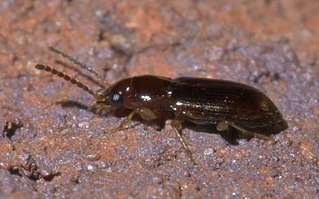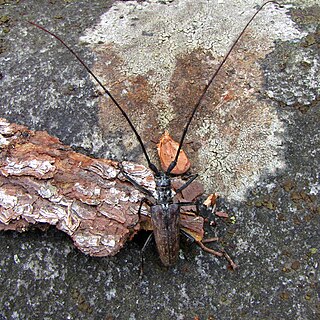
Curculio is a genus of weevils belonging the family Curculionidae and subfamily Curculioninae. Members of the genus are commonly referred to as acorn weevils or nut weevils as they infest the seeds of trees such as oaks and hickories. The adult female weevil bores a tiny hole in the immature nut to lay her eggs, which then hatch into legless grubs. In autumn, the grubs bore holes through the shells from the inside to emerge into the soil where they may live for a year or two before maturing into adults.

Monochamus is a genus of longhorn beetles found throughout the world. They are commonly known as sawyer beetles or sawyers, as their larvae bore into dead or dying trees, especially conifers such as pines. They are the type genus of the Monochamini, a tribe in the huge long-horned beetle subfamily Lamiinae, but typically included in the Lamiini today.

Harpalus is a genus of ground beetle first described by Pierre André Latreille in 1802.

Badister is a genus of ground beetle in the family Carabidae native to North Africa, the Near East, and the Holarctic, including Europe.

Polyptychoides is a genus of moths in the family Sphingidae erected by Robert Herbert Carcasson in 1968.

Bradycellus is a genus in the beetle family Carabidae. There are more than 120 described species in Bradycellus.

Selenophorus is a genus of beetles in the family Carabidae, first described by Pierre François Marie Auguste Dejean in 1831.

Borsoniidae is a monophyletic family of small to medium-sized sea snails, marine gastropod mollusks in the superfamily Conoidea.

Monochamus dubius is a species of beetle in the family Cerambycidae. It was described by Charles Joseph Gahan in 1894. It is known from India, Thailand, Myanmar, Vietnam, Taiwan, and China.
Monochamus lunifer is a species of beetle in the family Cerambycidae. It was described by Per Olof Christopher Aurivillius in 1891, originally under the genus Monohammus. It is known from Ghana.
Monochamus millegranus is a species of beetle in the family Cerambycidae. It was described by Henry Walter Bates in 1891. It is known from China. It feeds on Castanea mollissima.
Monochamus adamitus is a species of beetle in the family Cerambycidae. It was described by James Thomson in 1857. It is known from Tanzania, Sierra Leone, Angola, Ghana, Mozambique, the Ivory Coast, Senegal, the Democratic Republic of the Congo, Malawi, and Zimbabwe.

Monochamus sutor is a species of beetle in the family Cerambycidae. It was described by Carl Linnaeus in 1758, originally under the genus Cerambyx. It has a wide, natural distribution throughout Europe, and has also been introduced into Belgium and the Netherlands. Adults measure between 15 and 24 mm, and larvae measure up to 45 mm (1.8 in).

Monochamus clamator, the spotted pine sawyer, is a species of beetle in the family Cerambycidae. It was described by John Lawrence LeConte in 1852.

Monochamus galloprovincialis, the pine sawyer beetle, also referred to as the black pine sawyer beetle, is a species of beetle in the family Cerambycidae. It was described by Olivier in 1795, originally under the genus Cerambyx. It has a wide distribution, occurring naturally throughout Europe and the Caucasus. It has also been introduced into the Canary Islands. It serves as a vector for the parasitic nematode species Bursaphelenchus xylophilus, and also acts as a host to the parasitoid wasp species Dolichomitus tuberculatus.

Monochamus notatus, the northeastern pine sawyer or notable sawyer, is a species of beetle in the family Cerambycidae. It was described by Dru Drury in 1773, originally under the genus Cerambyx. It is known from Canada and the United States.

Monochamus ruspator is a species of beetle in the family Cerambycidae. It was described by Johan Christian Fabricius in 1781, originally under the genus Lamia. It has a wide distribution throughout Africa, and is also present in Kazakhstan.

Monochamus sartor is a species of beetle in the family Cerambycidae. It was first described by Johan Christian Fabricius in 1787, under the genus Lamia. It is known from throughout Europe, as well as in Kazakhstan, Mongolia, North Korea and South Korea. It is rated by the IUCN as Least Concern.

Stilbus is a genus of beetles commonly called the shining flower beetles belonging to the family Phalacridae.
Salvelinus obtusus, commonly called the blunt-nosed Irish charr or blunt-snouted Irish char, is a species of lacustrine char fish in the family Salmonidae, found in the Lakes of Killarney, Ireland.
















